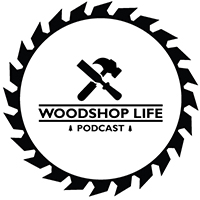Support us on Patreon: https://www.patreon.com/woodshoplife
Guy
1) Hey guys, I have been wanting to switch over to water based spray finishes for awhile, since for the foreseeable future my shop will remain connected to the house. I either use a conversion varnish or danish oil then wax. Doing oil and wax is a great look but too time consuming for any real deadline. That leads to conversion varnish but that requires a nice day outside or for the wife and kids to leave the house for a little while (museum, zoo, park, etc) Neither is practical and plus I want to go to the zoo too.
The argument against water based varnishes is the clear/milky look instead of a rich deep glow. But couldn’t you just spray an amber shellac coat first, sealing and giving the beautiful color that solvents give? Then finish with a quality water based coat, thinking Target Coatings EMTECH line.
Side note, I have used rubio and while I don’t mind it on occasion (I know guy is not a fan), I hate having to mix and the lack of options for sheen.
Thanks team! – Patrick
2) I have heard you all talk about how much you love and use for MFT tables and top and I love mine for those sweet, square, 27″ crosscuts. What I haven’t figured out yet is how to utilize it for much of anything else. I think one of you mentioned it as an assembly table, but it would be awesome to hear more ideas on how you utilize it your shops.
Thanks! Jeremy
Sean
1) Help me settle a bet with my wife.
She thinks I’m quote unquote “injury prone” in the woodshop. I always have Band-Aids on my hands and arms. She jokes that I am 30% bandaid at all times. I wouldn’t consider myself injury prone, other than that one chisel incident last summer (chisel into index knuckle, 10 stitches, yada yada yada).
My question is, on a normal day, how many minor injuries do you receive? Cuts, scrapes, splinters, scratches, anything that requires a bandaid. What do you consider the normal course of a day on this kind of thing? I need to explain to her that this kind of thing is just the cost of doing business.
Thanks again! – Eric
2) Hey Guys, Isaac from Teton Woodshop.
I have a question about drum sanders. I recently bought a drum sander because I don’t like sanding (shocker) and I thought it would cut down on sanding time for panels. However I found it left deep scratches in the wood that took quite awhile to sand out with the random orbital sander. I am finding much easier to just make sure my boards are flat, line up the glue joints with dominos and sand with a random orbital sander without using the drum sander. This process seems much faster for me.
Am I missing something in my use of the drum sander? I hear it is a luxury to have in the shop but I find it being more of a nuisance than a luxury at this point. I’d love to hear about how you guys use it to see why you consider it a luxury and I consider it a large space taker in the shop.
Huy
1) Hey Gents, wanted to say you have an awesome show going. Wanted to know if you’ve ever held off on making something because you don’t have a specific tool or upgraded tool? For instance I currently have a Dewalt jobsite table saw so not the most reliable or accurate saw and am saving up for a cabinet saw and think I’ll be more comfortable making things then. Thanks again. – Paul
2) I bought a cordless Dewalt track saw. I picked it because of the two way track and you don’t have to spin the tracks around as much when breaking down plywood. It was my first track saw. Now, I’m realizing that I can’t use the after market accessories available to Festool tracksaw owners like the parallel guides and the 90 degree guide. Do you think these accessories are worth selling my Dewalt and getting the Festool? I would like to move to final cuts with the track saw as mentioned by Guy in the last episode. – Brian
